wheel HONDA ODYSSEY 2022 Owners Manual
[x] Cancel search | Manufacturer: HONDA, Model Year: 2022, Model line: ODYSSEY, Model: HONDA ODYSSEY 2022Pages: 782, PDF Size: 27.17 MB
Page 6 of 782
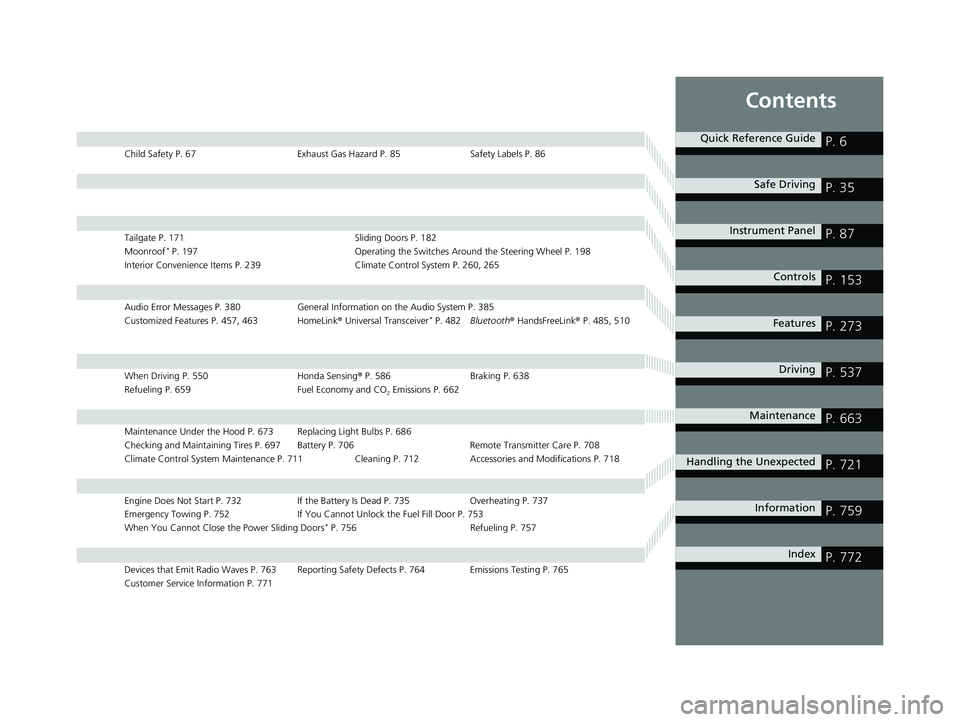
Contents
Child Safety P. 67Exhaust Gas Hazard P. 85Safety Labels P. 86
Tailgate P. 171 Sliding Doors P. 182
Moonroof* P. 197 Operating the Switches Around the Steering Wheel P. 198
Interior Convenience Items P. 239 Climate Control Syst em P. 260, 265
Audio Error Messages P. 380 General Information on the Audio System P. 385
Customized Features P. 457, 463 HomeLink ® Universal Transceiver* P. 482 Bluetooth ® HandsFreeLink ® P. 485, 510
When Driving P. 550 Honda Sensing® P. 586 Braking P. 638
Refueling P. 659 Fuel Economy and CO
2 Emissions P. 662
Maintenance Under the Hood P. 673 Replacing Light Bulbs P. 686
Checking and Maintaining Tires P. 697 Battery P. 706 Remote Transmitter Care P. 708
Climate Control System Maintenance P. 711 Clea ning P. 712 Accessories and Modifications P. 718
Engine Does Not Start P. 732If the Battery Is Dead P. 735Overheating P. 737
Emergency Towing P. 752 If You Cannot Unlock the Fuel Fill Door P. 753
When You Cannot Close the Power Sliding Doors
* P. 756 Refueling P. 757
Devices that Emit Radio Waves P. 763 Reporting Safety Defects P. 764 Emissions Testing P. 765
Customer Service Information P. 771
Quick Reference GuideP. 6
Safe DrivingP. 35
Instrument PanelP. 87
ControlsP. 153
FeaturesP. 273
DrivingP. 537
MaintenanceP. 663
Handling the UnexpectedP. 721
InformationP. 759
IndexP. 772
22 US ODYSSEY-31THR6400.book 5 ページ 2020年11月16日 月曜日 午後1時41分
Page 8 of 782
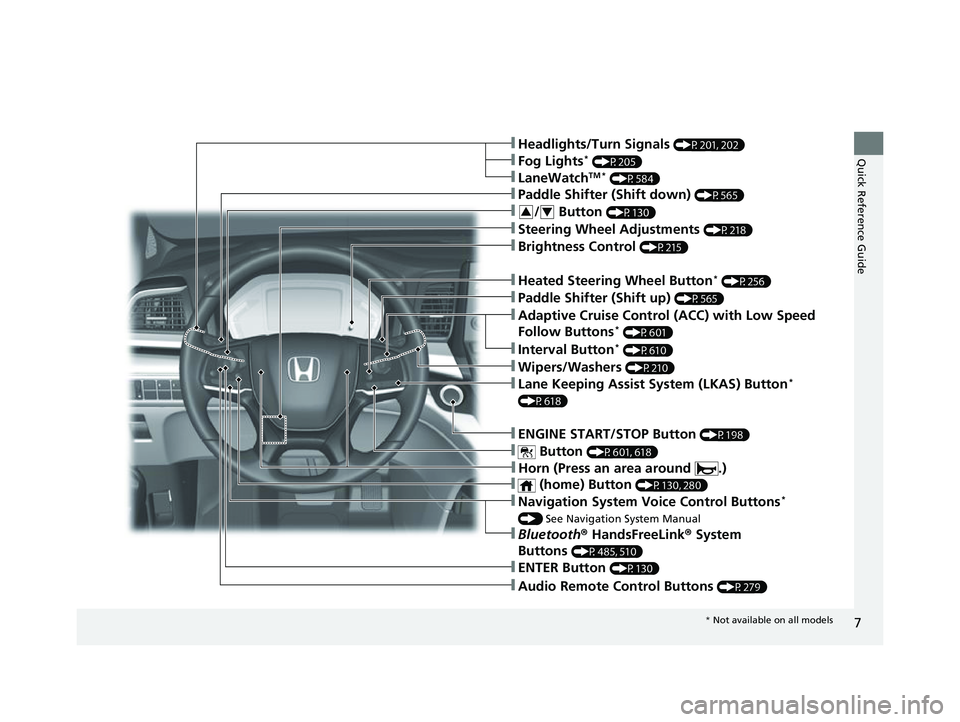
7
Quick Reference Guide
❚Navigation System Voice Control Buttons*
() See Navigation System Manual
❚Audio Remote Control Buttons (P279)
❚Steering Wheel Adjustments (P218)
❚Brightness Control (P215)
❚ENTER Button (P130)
❚/ Button (P130)34
❚Headlights/Turn Signals (P201, 202)
❚LaneWatchTM * (P584)
❚Fog Lights* (P205)
❚Bluetooth ® HandsFreeLink ® System
Buttons
(P485, 510)
❚Paddle Shifter (Shift down) (P565)
❚Heated Steering Wheel Button* (P256)
❚Paddle Shifter (Shift up) (P565)
❚Adaptive Cruise Control (ACC) with Low Speed
Follow Buttons* (P601)
❚Interval Button* (P610)
❚ENGINE START/STOP Button (P198)
❚ Button (P601, 618)
❚Wipers/Washers (P210)
❚Lane Keeping Assist System (LKAS) Button*
(P618)
❚ (home) Button (P130, 280)
❚Horn (Press an area around .)
* Not available on all models
22 US ODYSSEY-31THR6400.book 7 ページ 2020年11月16日 月曜日 午後1時41分
Page 15 of 782

14
Quick Reference Guide
Safe Driving (P35)
Airbags (P49)
●Your vehicle is fitted with airbags to help protect you and
your passengers during a moderate-to-severe collision.
Child Safety (P67)
●All children 12 and younger should be seated in the rear seat.●Smaller children should be properly restra ined in a forward-facing child seat.●Infants must be properly restrained in a rear-facing child seat.
Exhaust Gas Hazard (P85)
●Your vehicle emits dangerous exhaust gases that contain carbon
monoxide. Do not run the engine in confined spaces where
carbon monoxide gas can accumulate.
Before Driving Checklist (P39)
●Before driving, check that the front seats, head
restraints, steering wheel, and mirrors have been
properly adjusted.
Seat Belts (P40)
●Fasten your seat belt and sit upright well
back in the seat.
●Check that your passengers are wearing
their seat belts correctly.
Fasten your lap belt as
low as possible.
22 US ODYSSEY-31THR6400.book 14 ページ 2020年11月16日 月曜日 午後1時41分
Page 18 of 782

17
Quick Reference Guide
Turn Signals (P201)
Lights (P202)
Turn Signal Control Lever
Light Control Switches
Low Beam High Beam
Flashing
Wipers and Washers
(P210)
*1:Models with automatic intermittent wipers
*2:Models without au tomatic intermittent
wipers
AUTO should always be turned OFF before
the following situation in order to prevent
severe damage to the wiper system:
●Cleaning the windshield●Driving through a car wash●No rain present
Wiper/Washer Control Lever
Adjustment Ring
( -: Low sensitivity*1
(-: Lower speed, fewer sweeps*2
(+: High sensitivity*1
(+: Higher speed, more sweeps*2
MIST
OFF
AUTO
*1: Wiper speed varies automatically
INT*2: Low speed with intermittent
LO: Low speed wipe
HI : High speed wipe Pull toward
you to spray
washer fluid.
Models with automatic intermittent wipers
Steering Wheel (P218)
To adjust, push the adjustment lever down,
adjust to the desired position, then pull up
the lever back in place.
LeverTo lock
To adjust
22 US ODYSSEY-31THR6400.book 17 ページ 2020年11月16日 月曜日 午後1時41分
Page 31 of 782
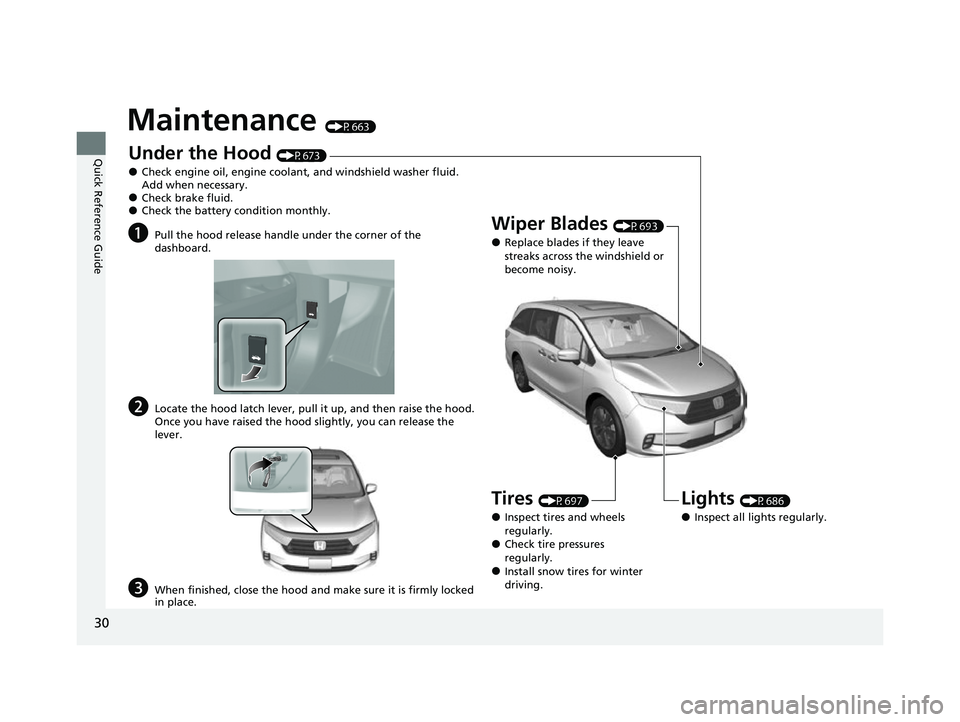
30
Quick Reference Guide
Maintenance (P663)
Under the Hood (P673)
●Check engine oil, engine coolant, and windshield washer fluid.
Add when necessary.
●Check brake fluid.●Check the battery condition monthly.
aPull the hood release handle under the corner of the
dashboard.
bLocate the hood latch lever, pull it up, and then raise the hood.
Once you have raised the hood slightly, you can release the
lever.
cWhen finished, close the hood and make sure it is firmly locked
in place.
Lights (P686)
●Inspect all lights regularly.
Wiper Blades (P693)
●Replace blades if they leave
streaks across the windshield or
become noisy.
Tires (P697)
●Inspect tires and wheels
regularly.
●Check tire pressures
regularly.
●Install snow tires for winter
driving.
22 US ODYSSEY-31THR6400.book 30 ページ 2020年11月16日 月曜日 午後1時41分
Page 33 of 782
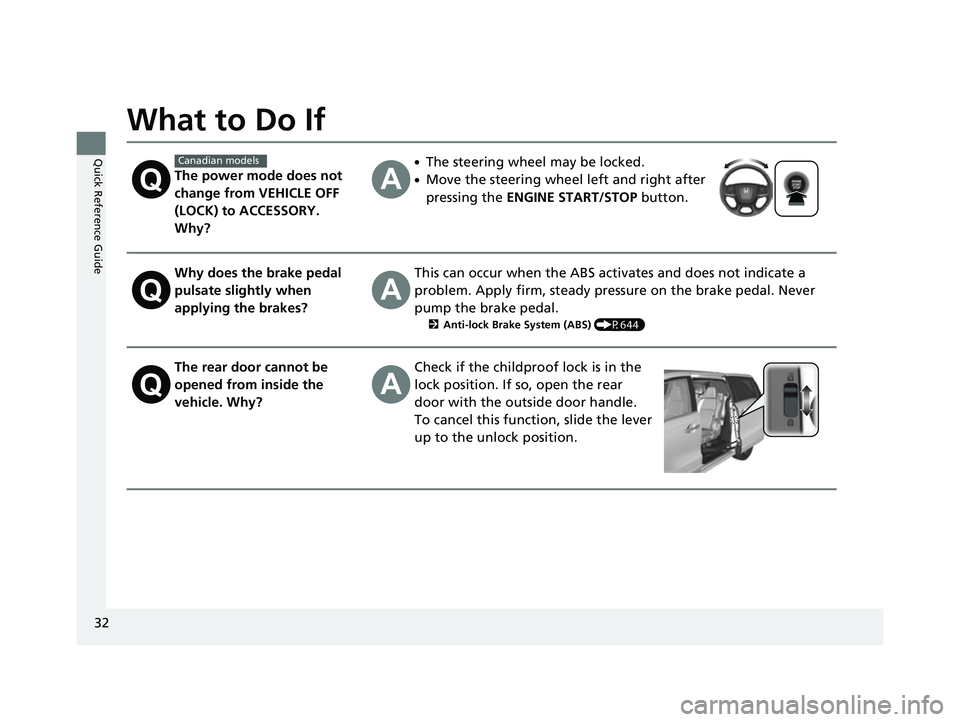
32
Quick Reference Guide
What to Do If
The power mode does not
change from VEHICLE OFF
(LOCK) to ACCESSORY.
Why?
●The steering wheel may be locked.
●Move the steering wheel left and right after
pressing the ENGINE START/STOP button.
Why does the brake pedal
pulsate slightly when
applying the brakes?This can occur when the ABS activates and does not indicate a
problem. Apply firm, steady pressure on the brake pedal. Never
pump the brake pedal.
2Anti-lock Brake System (ABS) (P644)
The rear door cannot be
opened from inside the
vehicle. Why?Check if the childproof lock is in the
lock position. If so, open the rear
door with the outside door handle.
To cancel this function, slide the lever
up to the unlock position.
Canadian models
22 US ODYSSEY-31THR6400.book 32 ページ 2020年11月16日 月曜日 午後1時41分
Page 51 of 782
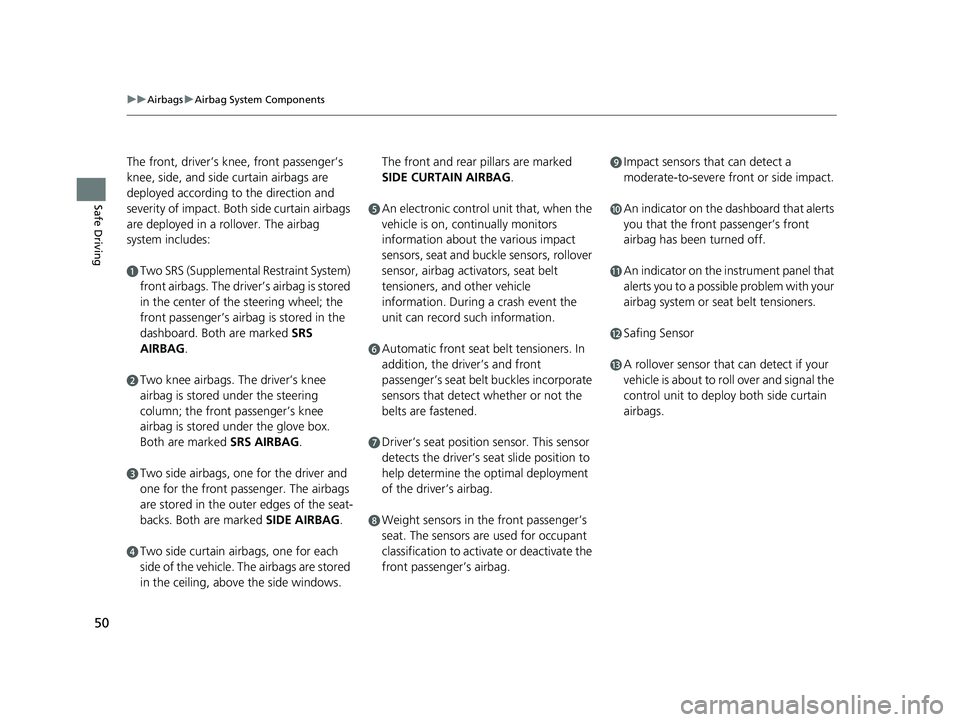
50
uuAirbags uAirbag System Components
Safe Driving
The front, driver’s knee, front passenger’s
knee, side, and side curtain airbags are
deployed according to the direction and
severity of impact. Both side curtain airbags
are deployed in a ro llover. The airbag
system includes:
aTwo SRS (Supplemental Restraint System)
front airbags. The driver’s airbag is stored
in the center of the steering wheel; the
front passenger’s airbag is stored in the
dashboard. Both are marked SRS
AIRBAG.
bTwo knee airbags. Th e driver’s knee
airbag is stored under the steering
column; the front passenger’s knee
airbag is stored under the glove box.
Both are marked SRS AIRBAG.
cTwo side airbags, one for the driver and
one for the front passenger. The airbags
are stored in the outer edges of the seat-
backs. Both are marked SIDE AIRBAG .
dTwo side curtain airbags, one for each
side of the vehicle. The airbags are stored
in the ceiling, above the side windows. The front and rear pillars are marked
SIDE CURTAIN AIRBAG
.
eAn electronic control unit that, when the
vehicle is on, continually monitors
information about the various impact
sensors, seat and buckle sensors, rollover
sensor, airbag activators, seat belt
tensioners, and other vehicle
information. During a crash event the
unit can record such information.
fAutomatic front seat belt tensioners. In
addition, the driver’s and front
passenger’s seat belt buckles incorporate
sensors that detect whether or not the
belts are fastened.
gDriver’s seat position sensor. This sensor
detects the driver’s seat slide position to
help determine the optimal deployment
of the driver’s airbag.
hWeight sensors in the front passenger’s
seat. The sensors are used for occupant
classification to activate or deactivate the
front passenger’s airbag.
iImpact sensors that can detect a
moderate-to-severe front or side impact.
jAn indicator on the dashboard that alerts
you that the front passenger’s front
airbag has been turned off.
kAn indicator on the instrument panel that
alerts you to a possib le problem with your
airbag system or seat belt tensioners.
lSafing Sensor
mA rollover sensor that can detect if your
vehicle is about to roll over and signal the
control unit to deploy both side curtain
airbags.
22 US ODYSSEY-31THR6400.book 50 ページ 2020年11月16日 月曜日 午後1時41分
Page 52 of 782
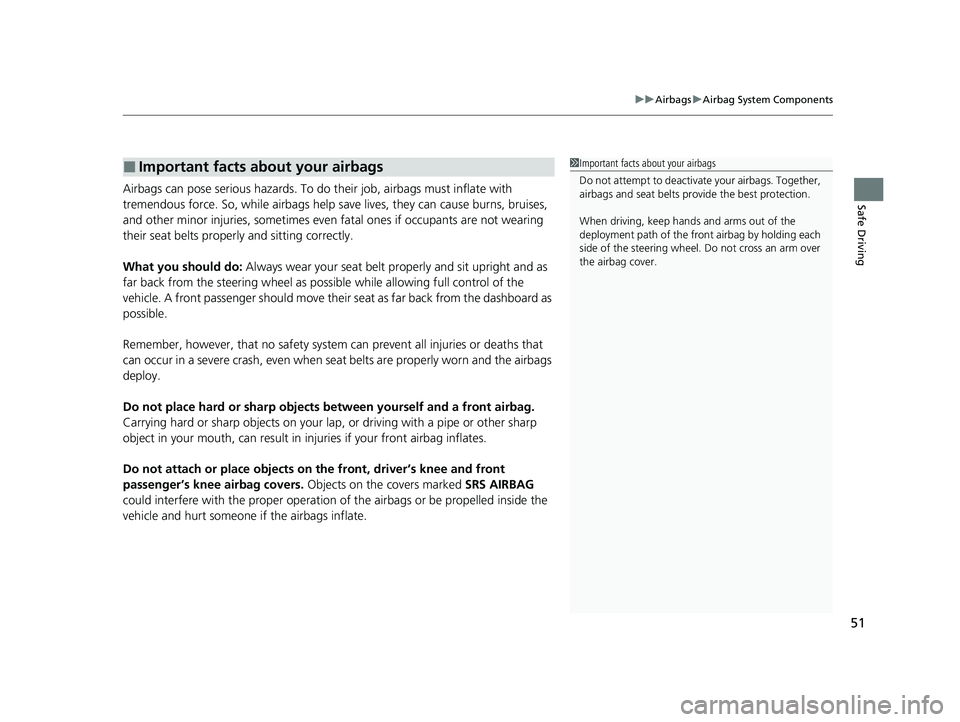
51
uuAirbags uAirbag System Components
Safe DrivingAirbags can pose serious hazards. To do their job, airbags must inflate with
tremendous force. So, while airbags help sa ve lives, they can cause burns, bruises,
and other minor injuries, sometimes even fatal ones if occupants are not wearing
their seat belts properl y and sitting correctly.
What you should do: Always wear your seat belt properly and sit upright and as
far back from the steering wheel as possible while allowing full control of the
vehicle. A front passenger should move their seat as far back from the dashboard as
possible.
Remember, however, that no safety system ca n prevent all injuries or deaths that
can occur in a severe crash, even when s eat belts are properly worn and the airbags
deploy.
Do not place hard or sharp objects between yourself and a front airbag.
Carrying hard or sharp objects on your lap, or driving with a pipe or other sharp
object in your mouth, can result in in juries if your front airbag inflates.
Do not attach or place objects on the front, driver’s knee and front
passenger’s knee airbag covers. Objects on the covers marked SRS AIRBAG
could interfere with the proper operation of the airbags or be propelled inside the
vehicle and hurt someone if the airbags inflate.
■Important facts about your airbags1 Important facts about your airbags
Do not attempt to deactivate your airbags. Together,
airbags and seat belts pr ovide the best protection.
When driving, keep hands and arms out of the
deployment path of the front airbag by holding each
side of the steering wheel. Do not cross an arm over
the airbag cover.
22 US ODYSSEY-31THR6400.book 51 ページ 2020年11月16日 月曜日 午後1時41分
Page 53 of 782
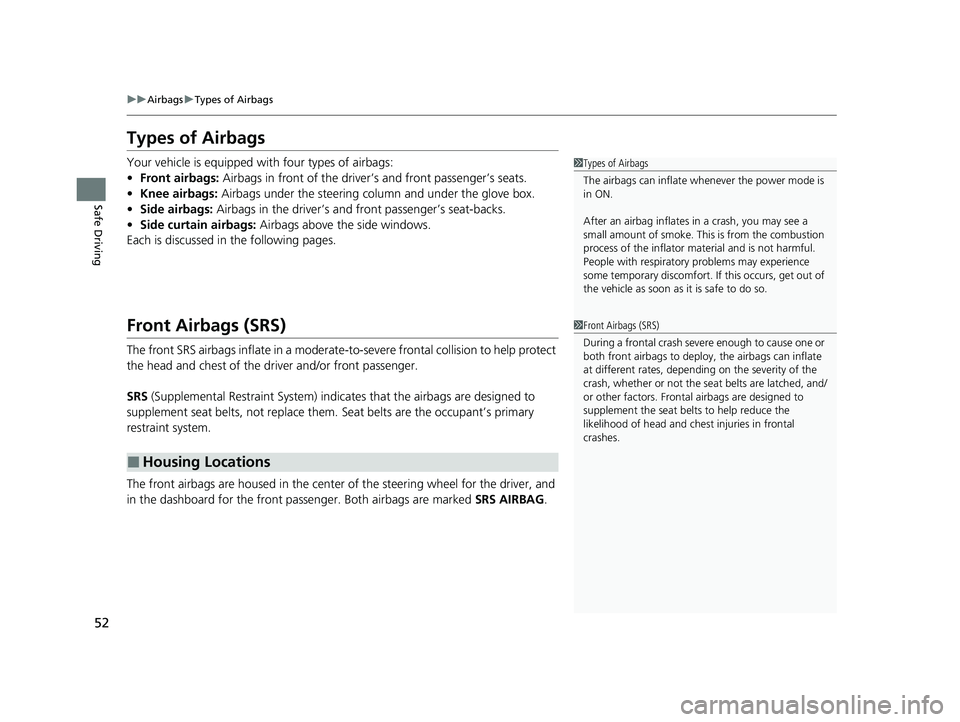
52
uuAirbags uTypes of Airbags
Safe Driving
Types of Airbags
Your vehicle is equipped with four types of airbags:
• Front airbags: Airbags in front of the driver ’s and front passenger’s seats.
• Knee airbags: Airbags under the steering column and under the glove box.
• Side airbags: Airbags in the driver’s and front passenger’s seat-backs.
• Side curtain airbags: Airbags above the side windows.
Each is discussed in the following pages.
Front Airbags (SRS)
The front SRS airbags inflate in a moderate-to -severe frontal collision to help protect
the head and chest of the driver and/or front passenger.
SRS (Supplemental Restraint System) indica tes that the airbags are designed to
supplement seat belts, not replace them. Seat belts are the occupant’s primary
restraint system.
The front airbags are housed in the center of the steering wheel for the driver, and
in the dashboard for the front pass enger. Both airbags are marked SRS AIRBAG.
■Housing Locations
1Types of Airbags
The airbags can inflate whenever the power mode is
in ON.
After an airbag inflates in a crash, you may see a
small amount of smoke. This is from the combustion
process of the infl ator material and is not harmful.
People with respiratory pr oblems may experience
some temporary discomfort. If this occurs, get out of
the vehicle as soon as it is safe to do so.
1 Front Airbags (SRS)
During a frontal crash severe enough to cause one or
both front airbags to deploy, the airbags can inflate
at different rates, dependi ng on the severity of the
crash, whether or not the se at belts are latched, and/
or other factors. Frontal airbags are designed to
supplement the seat belts to help reduce the
likelihood of head and chest injuries in frontal
crashes.
22 US ODYSSEY-31THR6400.book 52 ページ 2020年11月16日 月曜日 午後1時41分
Page 56 of 782
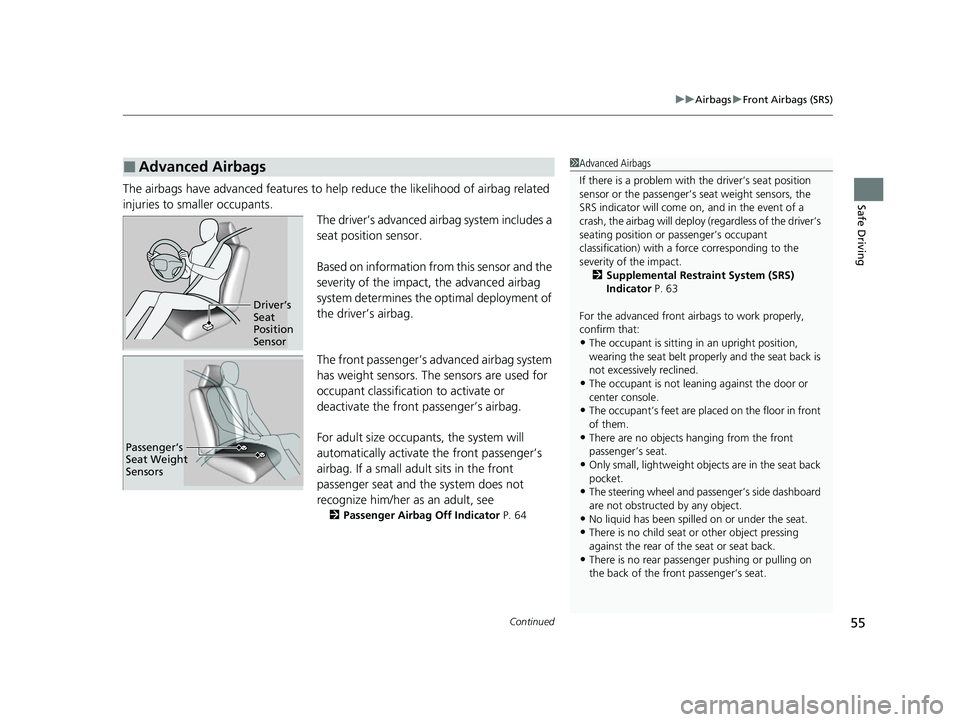
Continued55
uuAirbags uFront Airbags (SRS)
Safe DrivingThe airbags have advanced features to he lp reduce the likelihood of airbag related
injuries to smaller occupants. The driver’s advanced airbag system includes a
seat position sensor.
Based on information from this sensor and the
severity of the impact, the advanced airbag
system determines the optimal deployment of
the driver’s airbag.
The front passenger’s ad vanced airbag system
has weight sensors. The sensors are used for
occupant classification to activate or
deactivate the front passenger’s airbag.
For adult size occupant s, the system will
automatically activate the front passenger’s
airbag. If a small adult sits in the front
passenger seat and the system does not
recognize him/her as an adult, see
2 Passenger Airbag Off Indicator P. 64
■Advanced Airbags1Advanced Airbags
If there is a problem with the driver’s seat position
sensor or the passenger’s s eat weight sensors, the
SRS indicator will come on, and in the event of a
crash, the airbag will deploy (regardless of the driver’s
seating position or passenger’s occupant
classification) with a force corresponding to the
severity of the impact. 2 Supplemental Restraint System (SRS)
Indicator P. 63
For the advanced front airbags to work properly,
confirm that:
•The occupant is sitting in an upright position,
wearing the seat belt prope rly and the seat back is
not excessively reclined.
•The occupant is not leaning against the door or
center console.
•The occupant’s feet are plac ed on the floor in front
of them.
•There are no objects ha nging from the front
passenger’s seat.
•Only small, lightweight objec ts are in the seat back
pocket.
•The steering wheel and passenger’s side dashboard
are not obstructed by any object.
•No liquid has been spille d on or under the seat.•There is no child seat or other object pressing
against the rear of the seat or seat back.
•There is no rear passenger pushing or pulling on
the back of the front passenger’s seat.
Driver’s
Seat
Position
Sensor
Passenger’s
Seat Weight
Sensors
22 US ODYSSEY-31THR6400.book 55 ページ 2020年11月16日 月曜日 午後1時41分